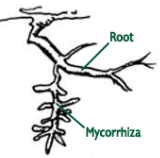Ever
been told that when transplanting a
beech tree, you should go
into the woods and dig some soil from under another beech and
put that into the new hole? Well, this is one old tale that
has some science behind it.
Dr. Donald
Marx has spent over 30 years studying tree roots as part of
his job with the U.S. Forest Service. Most of that time has
been spent researching a type of fungi called mycorrhiza.
These organisms form a close relationship with the roots of
most trees that benefits both the tree and the fungi.
 Mycorrhiza
grow on the fibrous feeder roots of the tree. They greatly
increase the ability of the root to absorb water and
nutrients. The fungus itself gets its nourishment from the
tree. All common trees and woody plants have mycorrhiza on
their root systems. Some have a specific species of the fungus
while others play host to many different types.
Mycorrhiza
grow on the fibrous feeder roots of the tree. They greatly
increase the ability of the root to absorb water and
nutrients. The fungus itself gets its nourishment from the
tree. All common trees and woody plants have mycorrhiza on
their root systems. Some have a specific species of the fungus
while others play host to many different types.
Trees with a healthy population of
mycorrhiza on their roots tend to grow better and are able to
withstand stress such as droughts. To keep the mycorrhiza
happy, the tree must be able to continually produce new feeder
roots for them to grow on. Anything that helps the tree with
this process will contribute to better overall health. This
means avoiding compaction in the root zone of trees and being
sure that water can penetrate deep into the root zone.
Work is underway to develop methods for
commercial production of mycorrhiza. That way, specific trees
could be inoculated with the most beneficial mycorrhiza
species at planting time. Unfortunately, nobody has been
able to come up with a system for keeping the fungi
viable while they sit on a shelf at the local nursery
store.



